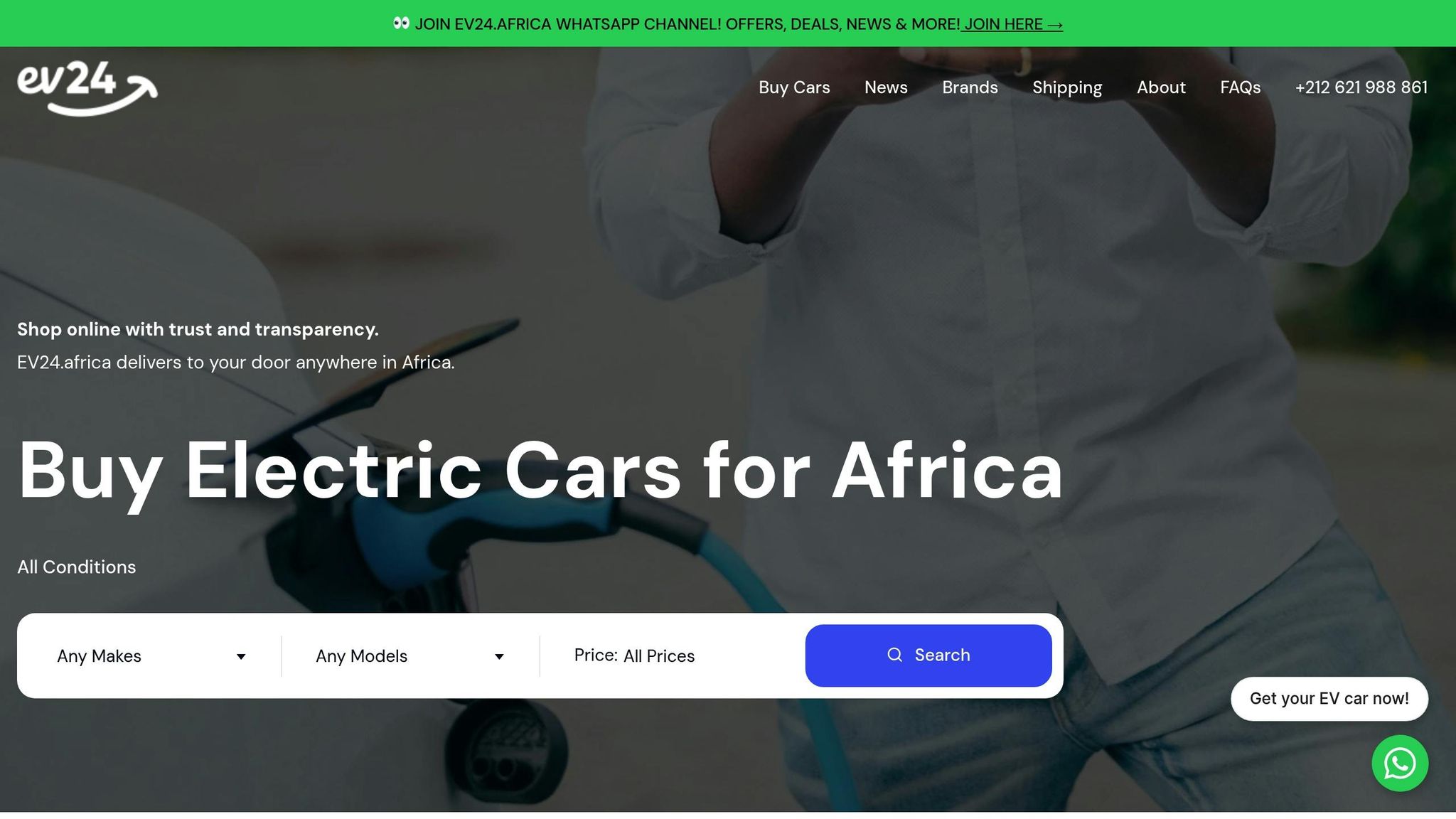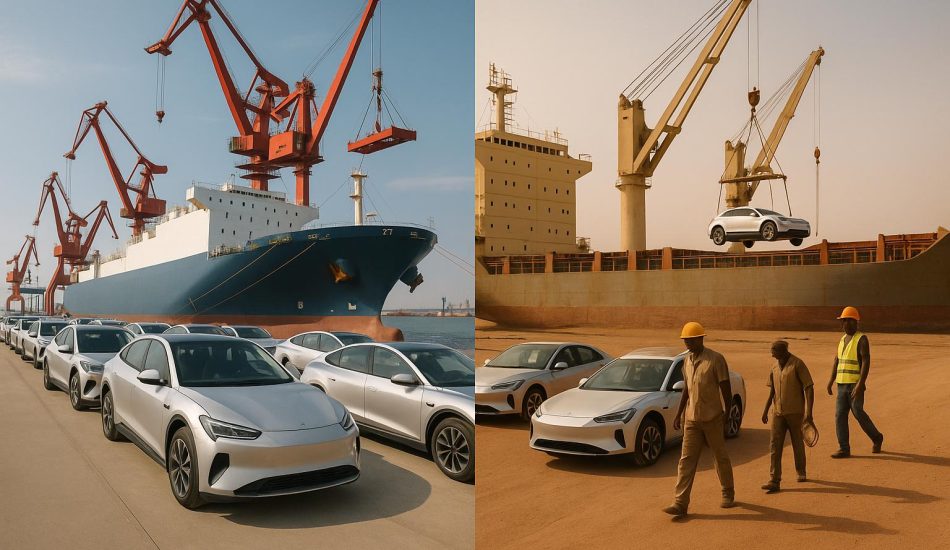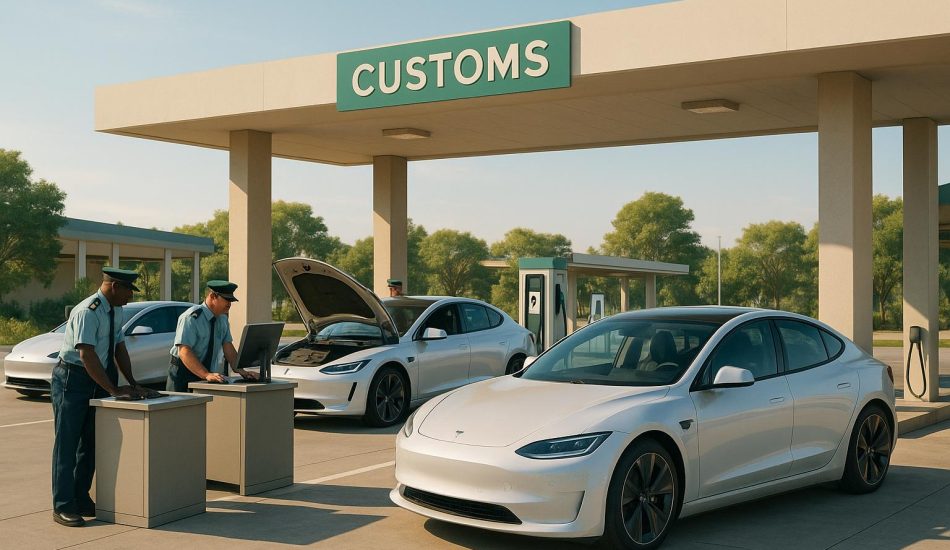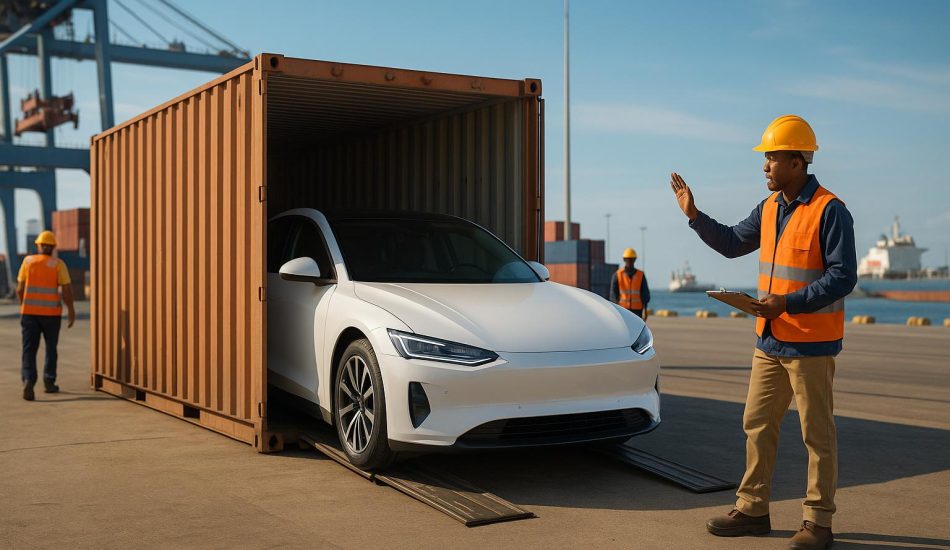
Rural electric mobility is transforming transportation in Africa’s rural areas by introducing electric vehicles (EVs) like motorcycles, tricycles, and small cars. These vehicles, paired with renewable energy solutions like solar-powered charging stations, offer affordable and reliable transport for passengers and goods. This shift addresses challenges like poor roads, high fuel costs, and unreliable electricity while improving access to healthcare, education, and markets.
Key Takeaways:
- Economic Impact: EVs reduce fuel costs, boost rural businesses, and improve access to markets. For example, solar-powered tricycles in Zimbabwe have increased incomes for women in rural areas.
- Social Benefits: Electric ambulances and school buses enhance healthcare access and education, especially for underserved communities.
- Environmental Gains: EVs lower emissions and noise pollution, improving rural living conditions.
- Challenges: Limited charging infrastructure, high upfront costs, and lack of technical expertise hinder adoption.
- Emerging Solutions: Projects like Mobility for Africa and ENGIE PowerCorner are piloting solar-powered EVs and mini-grids, addressing infrastructure gaps.
Platforms like EV24.africa are bridging gaps by offering affordable EVs, financing options, and delivery services to rural buyers. By integrating EVs with renewable energy and supporting local manufacturing, Africa is making strides toward cleaner, more accessible transportation in rural areas.
Current Programs and Initiatives in Rural Electric Mobility
Electric Mobility Projects in Africa
In Zimbabwe and Rwanda, Mobility for Africa is piloting electric tricycle projects aimed at improving rural connectivity and reducing transportation costs. These tricycles are supported by solar-powered charging stations, which are being tested in areas with limited access to the power grid. This approach not only addresses mobility challenges but also lays the groundwork for government policies that could further promote electric mobility in rural regions.
Government Role in Rural Electric Mobility
Kenya has introduced tax incentives and partnered with local financial institutions to make electric vehicles more accessible in rural areas. This is particularly important given that less than 20% of individuals over the age of 15 in Kenya have used formal financial services.
In Zambia, pilot programs are integrating rural electrification with electric mobility, ensuring that charging infrastructure is developed alongside energy projects. Meanwhile, Uganda and Rwanda are focusing their efforts on two- and three-wheeler electric vehicles. Collaborations with fintech companies have enabled mobile payment solutions, making it easier for rural communities to adopt electric vehicles.
Despite these advancements, challenges persist. Only 17% of African countries have 10 or more public charging stations, highlighting a significant infrastructure gap. To address this, governments are rolling out strategies specifically targeting rural development. Additionally, non-governmental organizations are stepping in to provide training, funding, and technical support to help establish and maintain charging infrastructure.
Benefits of Rural Electric Mobility
Economic Benefits
Electric mobility in rural areas provides a financial boost by replacing the unpredictability of fuel costs with stable electricity rates. This consistency helps rural businesses plan operations more effectively and manage transportation budgets with greater confidence.
Take the example of Mobility for Africa’s solar-powered tricycles in Zimbabwe. Since their launch in 2019, these vehicles have helped increase income for women by providing dependable transportation for business and agricultural needs. By improving access to markets, these solutions reduce post-harvest losses and create new income opportunities, enabling rural producers to reach urban markets more frequently. In Zimbabwe, where agriculture supports about 70% of livelihoods and contributes 15–20% of the GDP, such advancements in mobility can have far-reaching economic effects.
These financial benefits often serve as a stepping stone for broader improvements in the social fabric of rural communities.
Social and Community Benefits
Beyond economic advantages, electric mobility transforms access to essential services in rural areas. For instance, electric ambulances and motorcycles make emergency healthcare more accessible, especially in regions where fuel shortages have long been a barrier. Community health workers, equipped with electric motorcycles, can conduct more frequent home visits and vaccination drives, improving preventive care and overall health outcomes.
Affordable and reliable transportation also breaks down barriers to education. Electric school buses and transport services make travel safer and more cost-effective, particularly for girls who might otherwise face safety concerns during long commutes. This expanded access allows students to attend schools beyond their immediate villages, opening up new educational opportunities.
The predictability of electricity costs further helps rural communities plan regular travel for healthcare, education, and market access. It also improves connectivity to government services, banking, and specialized healthcare, fostering a stronger link between rural residents and essential resources.
Environmental Benefits
Switching to electric mobility brings clear environmental advantages. By cutting tailpipe emissions, electric vehicles improve air quality and reduce health problems caused by pollution. Additionally, quieter electric vehicles lower noise pollution, creating a more peaceful community environment that can reduce stress and improve sleep quality.
When paired with renewable energy sources like solar power, as demonstrated by projects such as ENGIE PowerCorner, electric mobility not only reduces dependence on fossil fuels but also ensures a consistent energy supply. This integration of renewables makes the transition to electric transportation even more impactful.
With around 450 million people in Africa’s rural areas lacking access to reliable mobility options, even a partial shift to electric solutions could significantly decrease greenhouse gas emissions. This change aligns with global climate goals while also reducing the environmental health challenges faced by rural communities.
Electric tricycles are a ticket to respect and prosperity for some rural women in Zimbabwe
Challenges and Barriers to Rural Electric Mobility
Rural EV adoption in Africa holds the promise of economic growth, social progress, and environmental benefits. But these opportunities face numerous obstacles that make widespread adoption a tough climb. The road to electric mobility in rural areas requires targeted solutions and consistent investment to overcome these hurdles.
Infrastructure and Energy Challenges
One of the biggest barriers is the lack of reliable electricity and charging infrastructure. Across Africa, only eight countries meet high standards for electrical grid reliability, which makes consistent EV charging nearly impossible in rural areas. Public charging stations are also scarce – just 17% of African nations have 10 or more stations, and most of these are concentrated in cities, leaving rural regions underserved.
On top of that, rural road networks are often in poor condition. Bad roads reduce vehicle efficiency and increase maintenance costs, creating additional challenges for EV users. In Zimbabwe, for instance, inadequate transport infrastructure has a direct impact on agriculture, which supports around 70% of the population and contributes 15–20% of the country’s GDP. The situation creates a vicious cycle: without reliable electricity and charging stations, EVs can’t function effectively. At the same time, building infrastructure is hard to justify without an existing demand for EVs.
These infrastructure gaps also lead to financial pressures that further slow down adoption.
Financial and Access Barriers
The high upfront cost of EVs is another major hurdle. For many rural households, purchasing an EV is simply out of reach, especially when financial services like loans or leasing options are limited. Even though EVs can save money on fuel in the long run, the initial investment remains a barrier.
Access to EVs is another issue. Sales and distribution channels are heavily concentrated in urban areas, making it harder – and more expensive – for rural buyers to purchase vehicles. Without local dealerships, potential buyers in rural areas miss the opportunity to see, test, or compare EVs before committing to a purchase. This lack of accessibility is especially problematic in communities unfamiliar with electric technology.
Market limitations also play a role. Small rural markets don’t benefit from economies of scale in infrastructure, distribution, or maintenance, which discourages investors from stepping in. These financial challenges are further complicated by a lack of technical support.
Skills and Maintenance Gaps
Technical expertise is critical for keeping EVs running, but it’s in short supply in rural areas. Without local mechanics trained to service EVs, owners often have to travel long distances for repairs, increasing costs and downtime. This is especially problematic for commercial vehicles used in agriculture and transport, where any downtime can directly affect livelihoods.
The lack of local maintenance services also hampers efforts to integrate EVs with renewable energy systems, which require specialized knowledge of electrical systems and battery storage. Until there’s investment in technical training and local service centers, rural EV users will remain dependent on urban providers, making adoption even more challenging.
Gender-specific barriers add another layer to these challenges. Women in rural areas often have lower incomes, limited access to financial services, and fewer property rights that could be used as collateral for loans. Traditional gender roles may also restrict their ability to make decisions about vehicle ownership, even though they often manage transportation needs for their families and communities.
Emerging Solutions
Despite these barriers, innovative projects are starting to make a difference. For example, since 2019, Mobility for Africa has been running a shared electric mobility service in Wedza, Domboshawa, and Chipinge, Zimbabwe. Using solar-powered tricycles and a battery-swapping system, the initiative has boosted incomes for women and helped the government develop a framework for electric mobility. Similarly, the ENGIE PowerCorner initiative has set up 13 mini-grids in Tanzania and Zambia, giving nearly 10,000 rural customers access to electricity and supporting electric mobility pilot programs in these areas.
These examples show that with the right approach, it’s possible to address some of the challenges holding back rural electric mobility. However, scaling these solutions will require continued effort and investment.
sbb-itb-99e19e3
How EV24.africa Supports Rural Electric Mobility

Rural electric mobility in Africa faces tough challenges, but solutions are starting to emerge. EV24.africa is tackling these barriers head-on by offering digital services that make electric vehicles (EVs) accessible even in the most remote areas. This online-first approach complements government and community efforts to expand electric mobility across the continent.
Wide Range of Electric Vehicle Options
EV24.africa provides an impressive variety of new and used EVs from top global brands like Tesla, BYD, Leapmotor, ROX, Dongfeng, Geely, Hyundai, Toyota, and Suzuki. This diverse lineup ensures rural buyers can find vehicles suited to their unique needs.
The platform offers detailed online listings with essential information such as vehicle specifications, clear pricing, and condition reports for used models. This transparency is a game-changer for rural customers who might not have access to urban showrooms. Instead of traveling long distances to explore options, buyers can compare and choose vehicles from the comfort of their communities.
For areas with challenging road conditions and limited budgets, compact EVs, along with electric two- and three-wheelers, are often the best fit. These vehicles are affordable, require minimal maintenance, and are well-suited for daily transportation in rural settings.
EV24.africa’s user-friendly platform bridges information gaps by offering clear, upfront pricing with no hidden fees. By removing the pressure often associated with traditional dealerships, rural customers can make informed decisions that meet their specific needs.
Financing and Delivery Services
High upfront costs and limited access to financing are some of the biggest hurdles to EV adoption in rural Africa. EV24.africa addresses these issues by providing a variety of financing options tailored to rural buyers. These include installment plans, lease-to-own agreements, and partnerships with local fintech firms. Considering that only 13% of Africans over 15 have accessed formal financial services or mobile money, compared to a global average of 30%, these flexible payment solutions are crucial for making EVs more attainable.
Delivery services are another standout feature of EV24.africa. The platform ensures vehicles are delivered across all 54 African countries, including remote rural areas where traditional dealerships are nonexistent. By leveraging local logistics networks, the company eliminates the need for rural customers to travel long distances to pick up their vehicles.
EV24.africa handles everything – from customs clearance to local registration – making the process seamless for buyers. This is especially important given that only 17% of African countries have 10 or more public charging stations, most of which are concentrated in cities. The platform’s delivery model ensures rural customers can access EVs without the added burden of navigating urban infrastructure.
This approach aligns with the broader adoption of digital platforms in Africa’s fintech sector, where innovative solutions are being used to provide credit and flexible payment options. For example, in Kenya, fintech companies have successfully introduced digital loans for electric two-wheelers, which are particularly popular in areas with low motorization rates. EV24.africa builds on this trend, paving the way for greater EV adoption in rural communities.
Future Outlook for Rural Electric Mobility in Africa
The future of rural electric mobility in Africa holds great promise, shaped by creative solutions tailored to the continent’s specific challenges. Key trends driving this transformation include renewable energy integration, the rise of local manufacturing, and a strong emphasis on gender inclusion.
Integration with Renewable Energy
Solar power is emerging as a game-changer for rural electric mobility in Africa. With over 450 million people in rural areas lacking dependable transportation options, solar-powered charging systems are making electric vehicles (EVs) practical in off-grid communities.
In Zimbabwe, Mobility for Africa’s "Hambas" tricycles rely on solar-powered battery swap systems to sidestep the need for traditional grid infrastructure. This approach allows rural communities to adopt electric mobility without waiting for large-scale infrastructure development.
Solar mini-grids are also making a significant impact. Take ENGIE’s PowerCorner initiative, for example. By 2020, it operated 35 mini-grids in Tanzania and Zambia, serving nearly 10,000 customers and laying the foundation for EV charging in rural areas. These mini-grids not only power EVs but also address broader electrification needs in the community.
Looking ahead, ECOWAS‘s ambitious plan to establish 128,000 mini-grids, supported by a $34.8 billion investment, is set to unlock even more opportunities for rural EV programs.
Battery swap systems are especially effective in rural contexts. They tackle range anxiety and save time by allowing drivers to quickly exchange depleted batteries for fully charged ones. Solar-powered swap stations can serve multiple vehicles, making EVs a practical and affordable choice for shared transportation models.
These renewable energy advancements are paving the way for local manufacturing efforts, which drive down costs and encourage self-reliance within communities.
Local Manufacturing and Assembly
Building on renewable energy innovations, local manufacturing initiatives are making EVs more affordable and accessible. By focusing on local production, African countries are reducing import costs, creating jobs, and building technical expertise.
The EMBRACE platform illustrates how international partnerships, like those between India and Africa, are helping to transfer e-mobility technologies while promoting local manufacturing and skill development.
Local assembly operations are gaining traction, particularly for simpler vehicles like two- and three-wheelers. These require less complex production processes and can incorporate locally sourced components where possible. Beyond vehicle production, this shift supports supply chains for batteries, charging equipment, and maintenance services.
The economic ripple effects are profound. Rural communities benefit from new jobs in assembly, sales, and technical support. Training programs are critical to this growth, equipping workers with the skills needed to assemble, maintain, and repair EVs. These initiatives ensure that rural areas have the expertise required for long-term adoption of electric mobility.
Focus on Gender Equity and Inclusion
Efforts to expand rural electric mobility are increasingly prioritizing gender equity. Women and marginalized groups in rural areas often face the greatest mobility challenges, making inclusive programs essential.
For example, Mobility for Africa’s initiative in Zimbabwe offers training opportunities specifically for women, helping them gain technical skills and economic independence. Women participating in these programs not only improve their mobility but also enhance their income potential, benefiting entire communities.
Microfinance schemes are also breaking barriers. Programs offering pay-as-you-go loans for electric motorcycles, like those facilitated by M-KOPA and Watu Credit, make vehicle ownership more accessible for women. These financing models recognize the unique financial needs of women and adapt to their circumstances, boosting participation rates.
Training programs for women in EV maintenance and driving are expanding, providing employment opportunities and ensuring local expertise for vehicle upkeep. When women gain better access to transportation, the benefits ripple outwards – families and communities see improved access to healthcare, education, and economic opportunities.
In Zimbabwe, 18,000 farmers are part of contract farming schemes where enhanced mobility could significantly boost productivity and income. Including women farmers in these initiatives amplifies the economic advantages.
Conclusion
Rural electric mobility in Africa is entering a pivotal moment, as creative solutions start to address long-standing challenges with the backing of a supportive ecosystem.
Success stories from countries like Kenya, Rwanda, and Uganda highlight how flexible digital financing is making electric vehicles (EVs) more accessible. Rural-focused efforts have not only increased incomes but also supported government development goals.
Renewable energy is poised to play a transformative role in this journey. ECOWAS has unveiled an ambitious plan to install 128,000 mini-grids by 2030, requiring an estimated $35 billion investment. Solar-powered battery swap systems are proving to be a practical solution, enabling communities to embrace electric mobility without relying on traditional grid infrastructure.
Platforms such as EV24.africa are breaking down barriers for rural buyers by offering transparent pricing, flexible financing options, and reliable delivery. By serving as a centralized marketplace across all 54 African countries, EV24.africa addresses challenges like vehicle availability and affordability, making EVs an achievable reality for more people.
Improved transportation access has ripple effects, especially for women, leading to better opportunities in healthcare, education, and economic participation. For example, in Zimbabwe – where agriculture employs about 70% of the population and contributes 15–20% of GDP – enhanced mobility can significantly boost productivity and household income. These broader community benefits highlight the far-reaching potential of rural electric mobility.
With local manufacturing, community-focused models, and accessible online platforms driving progress, the combination of innovative financing, renewable energy, and local production is bridging the mobility gap in rural areas. Rural electric mobility is emerging not just as a means of transportation but as a catalyst for reducing poverty, advancing gender equity, and building climate resilience.
FAQs
What are the biggest obstacles to adopting electric vehicles in rural Africa?
The spread of electric vehicles (EVs) in rural Africa comes with its fair share of challenges. One major hurdle is the scarcity of charging infrastructure. Many rural areas struggle with unreliable electricity access, making it tough to support the widespread use of EVs. Without dependable power sources, the idea of owning and operating an EV becomes far less practical.
Another significant barrier is the high upfront cost of electric vehicles. While EVs tend to have lower running costs over time, the initial expense can be a major obstacle for communities with limited financial means.
On top of these issues, there’s a gap in awareness and technical knowledge. Many rural communities are unfamiliar with EV technology, including how to maintain and repair these vehicles. Overcoming these challenges will require targeted investments in infrastructure, educational initiatives, and policies that ensure EVs and charging solutions are both accessible and affordable for rural areas.
How do solar-powered charging stations operate in rural areas with limited access to electricity?
Solar-powered charging stations work by using solar panels to capture sunlight and convert it into electricity, which is then used to charge electric vehicles (EVs). Many of these setups also include battery storage units to save surplus energy, ensuring that power is available even on cloudy days or during nighttime hours.
In rural areas where access to the power grid is limited, these stations offer an independent and reliable solution for EV charging. By tapping into renewable energy, they reduce dependence on fossil fuels and make electric transportation more practical in remote locations. This is especially impactful in regions like Africa, where the abundance of sunlight can be leveraged to support rural electric mobility projects effectively.
What steps are being taken to make electric vehicles more affordable and accessible in rural African communities?
Efforts to bring electric vehicles (EVs) to rural Africa are centered on making them more affordable and accessible. Governments and organizations are stepping in with subsidies, tax breaks, and reduced import duties, all aimed at cutting the initial costs of EVs. On top of that, there are financing programs that let buyers pay in installments, easing the financial burden for rural families.
Another critical area is building the necessary infrastructure. This includes setting up charging stations in rural regions and encouraging the adoption of solar-powered charging systems, which are both economical and environmentally friendly. Companies like EV24.africa are also playing a vital role by offering a platform where users can explore various electric vehicle options, access clear pricing, and even arrange deliveries to remote locations. These combined efforts are helping rural communities embrace electric mobility.




